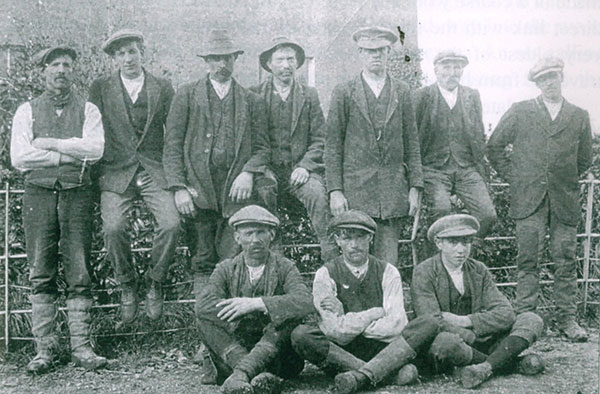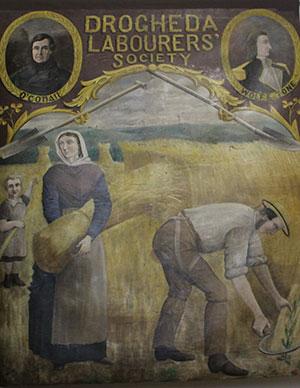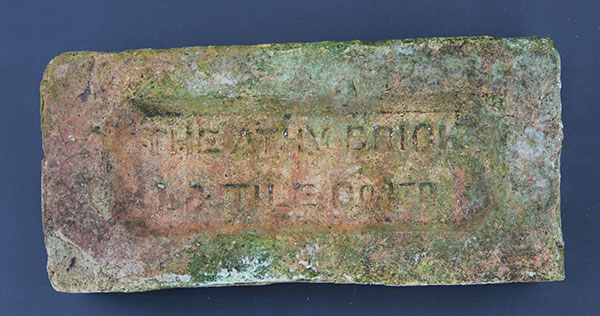‘Meath is rich, Meath’s workers are poor’
Published in Features, Issue 4 (July/August 2019), Volume 27The Kildare and Meath farm labour strike, 1919.
By Terry Dunne
The country lanes and byways across the plains of Meath and Kildare were the setting for a showdown in the summer of 1919. According to a confidential police report, there was ‘serious dislocation’:
‘The Agricultural Show at Navan had to be abandoned, the fairs at Navan and Trim were complete failures, farmers being afraid to send their stock, and the roads to Dublin were picketed to prevent cattle being sent to the Dublin Market’.
This was the Meath and Kildare farm labour strike of 1919—an epicentre of the revival of the Irish Transport and General Workers’ Union (ITGWU). By 1919 as much as half of the union’s membership worked in agriculture. In the summer of that year it faced an organised response from farmers in the form of the Irish Farmers’ Union. An attempted lockout in Kildare and a refusal on the part of farmers in Meath to negotiate on wages led to strike action across both counties. On 12 July the Meath Chronicle reported:
‘… rather exciting scenes were witnessed on the roads leading from Meath to Dublin, and at the entrances to Kilmessan, Drumree, Batterstown, and Dunboyne [railway] Stations, where large parties of strikers intercepted stock belonging to farmers involved in the strike, which has become general in South Meath, and turned the droves of cattle, sheep, etc., back except where drovers had permits issued by the Strike Committee’.

Above: Workers on the Jackson farm in Kilkea, south Kildare, c. 1919. Note the British Army caps on two of the men. (Greene family)
The following week the newspaper reported on an attempt ‘to raise the blockade’, which featured ‘a flock of thirteen sheep conducted to the Drumree station by eleven policemen—led by a sergeant and head constable—who drove back the pickets with fixed bayonets’.
A hidden revolution?
For most of modern Irish history agriculture was the country’s pre-eminent industry. The popular memory of the agrarian past is one of thatched cottages and small farms, a popular memory shaped by rich literary and ethnographic traditions. But there was another rural Ireland, one where agriculture was the largest employment sector for male workers—a hidden Ireland of large farms employing wage labourers and adopting the latest technologies. In the years between 1917 and 1923 that hidden Ireland pulsed to the beat of a hidden revolution. While Tan and Civil Wars dominate the national narrative, clearly more things were going on: during the so-called Treaty election of 1922, when the country apparently divided into rival pro- and anti-Treaty camps, socialist candidate Cathal O’Shannon topped the poll in the Meath constituency. Across the Irish Free State 21.3% of first-preference votes went to Labour (a shade lower than that to anti-Treaty Sinn Féin), and a further 7.8% to the Farmers’ Party, the political wing of the Irish Farmers’ Union. Meanwhile, particularly in the West, the Land War was not just a memory. Galway, for instance, saw several agrarian assassinations in 1922.
State intervention formed the background to the growth of agricultural trade unionism from 1917 onwards. As part of war mobilisation the government introduced compulsory tillage, under which farmers had to have a portion of their land under crops other than grass. The government also introduced minimum wage setting for agriculture. These interventions aimed to secure food supply, as there was a great inflation in food prices in these years and fear of a subsistence crisis. Local minimum wages were set to make sure that agriculture had a workforce, in case workers would simply leave the land for better-paying jobs in arms and ammunition factories. More tillage meant a higher demand for labour, and the process of wage setting meant more need for representation.

Above: Drogheda Labourers’ Society—a rare agricultural workers’ trade banner, c. 1873, produced by Meath artist William Reynolds. In a process of radicalisation, the ITGWU spread out into rural areas, absorbing such local organisations. (Drogheda Museum)
From March 1917 on, all across the east and south there was a flurry of wage demands; new organisations were established and old organisations revived. Older organisations like the Meath Labour Union and various local land and labour associations had campaigned for rural public housing. This demand was realised in the Labourers’ (Ireland) Act of 1906 and other related legislation, dating back as far as 1883. By 1914, 50,000 council cottages had been built for rural workers. In a process of radicalisation, the ITGWU spread out into rural areas, absorbing local organisations. The legacy of sporadic farm labourer organising found a new departure in the form of the ITGWU. The Transport Union was something new in that it aimed to organise all workers, where sharp status distinctions divided craftsmen and clerical employees from general labourers such as farm workers or dockers. It was new also in that it espoused a socialist vision of a new world and promoted a class ethic of solidarity. Small wonder, then, that employers were not overly welcoming. Incongruous as it seems today, part of the policy platform of the Irish Farmers’ Union/Party was opposition to land nationalisation. There were more things in the mix in those years than the later conservative history of the Irish Free State would suggest.
Started as a lockout
The Meath and Kildare farm labour strike of July and August 1919 began with a localised lockout in Celbridge in north Kildare, which the Kildare farmers’ organisation sought to extend into a county-wide lockout against the Transport Union. The strike was called before the lockout went into effect. In Meath, while the farmers’ organisation had met the more moderate demands of the Meath Labour Union, they refused to negotiate on the higher wage demands of the ITGWU. The striking workers had two essential tools over and above the simple withdrawal of labour. In the first place, there was the sort of robust picketing described above, where strikers sought to shut down any trading activity conducted by recalcitrant farmers. In the second, there was the crucial support of other groups of workers: the drovers who moved cattle to and from the market in Dublin’s Stoneybatter and the dockers who loaded them onto ships bound for England. Ireland’s agrarian economy had its urban as well as its rural workforce.
The agrarian economy revolved around the cross-Channel cattle trade. In a parallel with modern workplaces, different stages of production took place at different sites: beef cattle might be born in one county, raised in another and fattened in yet another, before a final trip to England. There was a constant flow which could be interrupted, either by blocking roads or railway stations or by sympathetic action by other workers further along the commodity chain. Moreover, in the summer of 1919 drought conditions were limiting grass growth as well as animal growth, and hence also the growth in the bank balance of farmers. There was thus a heightened need for farmers to get stock off their hands.

Above: A brick from the Athy Brick and Tile Company, used in local rural public housing. By 1914, 50,000 rural labourers’ cottages had been built across the country.
In the middle of the strike, an attempt to breach the blockade was made by a diversion to Belfast. Belfast port was divided into confessional enclaves, with Protestants dominating the parts of the docks dealing with shipping to Britain. They had remained members of the ITGWU’s rival, the National Union of Dock Labourers. The farmers’ hope was that loyal Belfast would not stand with the republican Transport Union. This hope was dashed; stock was sent back from the mouth of the Lagan to the plains of Meath.
IRA hoodwinked into support?
As July rolled into August some individual farmers started to settle. Hold-outs sought to escalate their entrenched resistance with more support from the state: 400 soldiers arrived in Navan on 10 August. There were rumours that scab labour was to be recruited. But a secret army was also mobilising. In the middle of the month the railway line that passed through Navan was sabotaged by the local IRA. It is unclear whether they thought they were hindering the outward movement of cattle or the inward movement of British troops. Many years later one IRA officer, Seamus Finn, claimed to the Bureau of Military History that Eamon Rooney, ITGWU organiser for Meath, had hoodwinked them into undertaking this action. County-wide agreements brought the strike to an end towards the end of August, winning higher wages for farm workers.
Meanwhile, a conflict of a different sort was unfolding in Athy, the market town in the cereal-producing south of County Kildare. Conflict was provoked there through the coincidence of the Peace Day celebrations marking the end of the Great War with celebrations greeting the return of a republican political prisoner. Local Peace Day plans had actually been cancelled to avoid strife, but the Athy district had produced a large number of recruits to the British Army, with approximately 2,000 men from the area having served in the war. Several days of fracas saw bands of demobilised soldiers tear down republican bunting, sack the business premises of a prominent republican activist and fist-fight with their opponents in the streets. IRA volunteers mobilised to prevent further attacks on businesses. Testament to the radicalising effect of the farm labour strike, the next we hear of Athy’s veterans is in January 1920. Then, at a local election rally, Labour speakers were brought to the podium behind ‘the local ex-soldiers’ fife and drum band’, while ex-soldiers present ‘loudly cheered every reference to the Workers’ Republic’. While the Athy case was particularly dramatic, there was a broader history of clashes between separatists and the poorer urban communities who supplied army recruits, and there were Peace Day riots elsewhere.
Not an isolated event
The Meath and Kildare farm labour strike was not an isolated event; it was a particularly large flashpoint in a conflict ongoing across the country. Not only did the strike encompass adjacent districts in Louth, Dublin, Wicklow, Laois and Carlow but 1919 also saw agricultural labour disputes on a more localised scale in east Donegal, east Galway, north Cork, Kerry, Limerick, Tipperary, Wexford and Dublin.
Another lockout in south Kildare in the winter of 1922–3 gives a sense of the place of the rural working class in the new Irish Free State. There the local branch of the Irish Farmers’ Union successfully lobbied the Minister for Agriculture, who in turn lobbied the Minister for Defence, for the arrest and imprisonment of leading worker activists. In the post-war situation of lower labour demand it was very difficult for agricultural workers to organise and mobilise. Undoubtedly the Irish Free State was a cold place for the rural working class but some among their number had tried to create a different future in the revolutionary years.
Kildare native Terry Dunne researches agrarian social movements of the nineteenth and twentieth centuries.
FURTHER READING
O. Coogan, Politics and war in Meath 1913–23 (Navan, 2013).
E. O’Connor, Syndicalism in Ireland 1917–1923 (Cork, 1988).
E. O’Connor, A labour history of Ireland 1824–2000 (Dublin, 2011).
M. Ó Dubhshláine, Are you going home now? Memories of Old Kilkea (Tralee, 2006).
















